Cuneo Italy / Italia
- Maria Scuor
- Jun 14
- 17 min read
Italian under each section
We have been blessed to visit Cuneo often due to Gianni having his bone marrow transplant at the Santa Croce Hospital. It is a beautiful town, like many in Italy that is full of history and architecture. Cuneo is a municipality in Piedmont, Italy and is the capital of the province of Cuneo. The name Cuneo means “Wedge” and is situated on a plateau in a triangle, a wedge, at the junction in the plain between the river Stura and the torrent Gesso. The city is dominated by Mount Bisalta.
The first documents where Cuneo appears dates back to June 23, 1198 and is presumably born as a result of freeing themselves from the bishops of Asti and the marquises of Montferrat and Saluzzo. The conflict with Marquis Saluzzo however continued and in 1210 he returned to rule the lands. By 1231 the Cuneesi people rebelled and by 1238 the Emperor Frederick II recognized Cuneo as a free commune.
This didn’t last long and as many towns in Italy, Cuneo was ruled by many entities. By 1382 it became part of the Savoy lands and during the century’s construction intensified and changes to the medieval layout occurred. By 1559, Duke Emanuele Filiberto raised Cuneo to rank of city because of its military merits.
By the end of the 17th century, the bastion wall was built and Cuneo assumed the role of fortress city. However, it didn’t give up on adapting to new technologies and economic trends such as the water wheel mills for twisting silk thread which the city became a production and export centre. In 1800 the French ceased the town and demolished the wall that over centuries had resisted many sieges.
In 1814 the Savoy regained control for three years when in 1817 Cuneo returned to the clergy and this began a very prosperous time for the city, especially in the field of education. By the 19th century the markets prospered, especially those related to chestnuts and cattle. This gave way to the development of the banking system.
During the First World War, Cuneo lost about 400 people and over 200 mutilated. Then during World War II, from 1943 to 1945, Cuneo was a partisan resistance against the German occupation of Italy and after the fall of Mussolini on July 25, 1943, Duccio Galimberti called the people of Cuneo to war against the Germans. But the Germans on September 12th entered the city with tanks and assassinated Galimberti. Then by January 3rd they returned to Boves, municipality in Cuneo, and burned the down destroying 350 homes and killing more than 60 people. Cuneo was awarded the Gold Medal of Military Valour on August 1, 1947.
Today, we can drive into Cuneo over the Sture di Demonte river on top of the Soleri viaduct which is a road and railway viaduct that is absolutely stunning. Cuneo has a beautiful vibrant historic centre and Piazza Galimberti is the city’s main square with the statue of Galimberti standing tall in the centre of the square and has a population of almost 56,000 people. Here are some of the things we saw in Cuneo.
Cuneo Italia
Abbiamo avuto la fortuna di visitare Cuneo spesso a causa del trapianto di midollo osseo di Gianni presso l'Ospedale Santa Croce. È una città bellissima, come tante in Italia, ricca di storia e architettura. Cuneo è un comune italiano della provincia di Cuneo. Il nome Cuneo deriva dal fatto che la città è situata su un altopiano a forma di triangolo, un cuneo, all'incrocio in pianura tra il fiume Stura e il torrente Gesso. La città è dominata dal Monte Bisalta.
I primi documenti in cui compare Cuneo risalgono al 23 giugno 1198 e nasce presumibilmente a seguito della liberazione dai vescovi di Asti e dai marchesi del Monferrato e di Saluzzo. Il conflitto con il marchese Saluzzo però continuò e nel 1210 tornò a governare le terre. Nel 1231 i Cuneesi si ribellarono e nel 1238 l'imperatore Federico II riconobbe Cuneo come libero comune.
Questo non durò a lungo e come molte città in Italia, Cuneo fu governata da molte entità. Nel 1382 entrò a far parte delle terre sabaude e nel corso del secolo la costruzione si intensificò e si modificarono l'impianto medievale. Nel 1559, il duca Emanuele Filiberto elevò Cuneo al rango di città per i suoi meriti militari.
Entro la fine del XVII secolo fu costruito il muro bastionale e Cuneo assunse il ruolo di città fortezza. Tuttavia, non ha rinunciato ad adattarsi alle nuove tecnologie e alle tendenze economiche come i mulini a ruota idraulica per la torsione del filo di seta di cui la città è diventata un centro di produzione ed esportazione. Nel 1800 i francesi cessarono la città e demolirono la cinta muraria che nei secoli aveva resistito a molti assedi.
Nel 1814 i Savoia ne ripresero il controllo per tre anni quando nel 1817 Cuneo tornò al clero e iniziò così un periodo molto florido per la città, soprattutto nel campo dell'istruzione. Nel XIX secolo i mercati prosperarono, soprattutto quelli legati alle castagne e al bestiame. Questo ha dato il via allo sviluppo del sistema bancario.
Durante la Prima Guerra Mondiale, Cuneo perse circa 400 persone e oltre 200 mutilati. Poi durante la seconda guerra mondiale, dal 1943 al 1945, Cuneo fu una resistenza partigiana contro l'occupazione tedesca dell'Italia e dopo la caduta di Mussolini, il 25 luglio 1943, Duccio Galimberti chiamò il popolo cuneese alla guerra contro i tedeschi. Ma i tedeschi il 12 settembre entrarono in città con i carri armati e assassinarono Galimberti. Poi il 3 gennaio sono tornati a Boves, comune di Cuneo, e hanno incendiato la fossa distruggendo 350 case e uccidendo più di 60 persone. Cuneo fu insignito della Medaglia d'Oro al Valor Militare il 1° agosto 1947.
Oggi possiamo guidare a Cuneo attraverso il fiume Sture di Demonte in cima al viadotto Soleri, che è un viadotto stradale e ferroviario assolutamente stupefacente. Cuneo ha un bellissimo e vivace centro storico e Piazza Galimberti è la piazza principale della città con la statua di Galimberti che svetta al centro della piazza e ha una popolazione di quasi 56.000 persone. Ecco alcune delle cose che abbiamo visto a Cuneo.
Soleri Viaduct – Viadotto Soleri
The Soleri viaduct takes its name from Marchello Soleri, a distinguished lawyer and mayor of Cuneo at the age of 30. He contributed to the city and the nation after World War II. The viaduct is a mix of road and rail with the 768 m (2519 ft) long road bridge and the 858 m (2815 ft) long railway. It has 34 arches and the bridge diverges towards the city into two branches, one the road and one the railway. In the common branch you can see that the roadway is superimposed on the double railway track and supported by reinforced concrete pillars.
The road section was built between 1913-1933 and the railway section from 1913 to 1937 as it was built with the Cuneo station. It took so long because in the post-war period there was an urgent need for more work to be done and so the work stopped. Then, on June 5, 1930, one of the pylons collapsed and killed 11 workers. There were also many technical problems that delayed everything, but the diversion of funds for the war in Ethiopia blocked the situation again.
Finally, on October 28, 1933, the road section was inaugurated and then the inauguration of the railway section took place on November 7, 1937. However, on April 29, 1945, retreating German soldiers destroyed three viaducts crossing the Stura at Cuneo completely cutting off rail communications and main road access. This put the road and rail route out of service for three years. The restoration work was completed and on January 10, 1948 there was a solemn inauguration.
Unfortunately, the bridge became famous for being a place of numerous suicides, so the municipality of Cuneo had to install high fences along the entire length of the road bridge.
Viadotto Soleri
Il viadotto Soleri prende il nome da Marchello Soleri, insigne avvocato, sindaco di Cuneo all'età di 30 anni. Ha contribuito alla città e alla nazione dopo la seconda guerra mondiale. Il viadotto è un mix di strada e ferrovia con il ponte stradale lungo 768 m e la ferrovia di 858 m. Ha 34 arcate e il ponte diverge verso la città in due rami, uno la strada e uno la ferrovia. Nel ramo comune si vede che la carreggiata è sovrapposta al doppio binario ferroviario e sorretta da pilastri in cemento armato.
Il tratto stradale fu realizzato tra il 1913-1933 e il tratto ferroviario dal 1913 al 1937 in quanto costruito con la stazione di Cuneo. Ci è voluto così tanto tempo perché nel dopoguerra c'era urgente bisogno di altri lavori da fare e quindi i lavori si sono fermati. Poi, il 5 giugno 1930, uno dei tralicci crollò e uccise 11 operai. Ci sono stati anche molti problemi tecnici che hanno ritardato tutto, ma la diversione dei fondi per la guerra in Etiopia ha bloccato di nuovo la situazione.
Finalmente il 28 ottobre 1933 fu inaugurato il tratto stradale e poi l'inaugurazione del tratto ferroviario avvenne il 7 novembre 1937. Tuttavia, il 29 aprile 1945, i soldati tedeschi in ritirata distrussero tre viadotti che attraversavano la Stura a Cuneo interrompendo completamente le comunicazioni ferroviarie e l'accesso stradale principale. Ciò mise fuori servizio il tracciato stradale e ferroviario per tre anni. I lavori di restauro furono completati e il 10 gennaio 1948 ci fu una solenne inaugurazione.
Purtroppo, il ponte divenne famoso per essere stato un posto di numerosi suicidi, pertanto il comune di Cuneo dovette installare alte recinzioni lungo tutta la lunghezza del ponte stradale.
Cuneo Porticoes – Portici di Cuneo
Cuneo is known as the “city of porticos” even though it has the fourth longest infrastructure of them with only Bologna, Torino and Padua being longer. It is because of their architectural elements in the historic centre that makes them fascinating.
There are 8km of porticoes and were born of necessity as between the 17th and 18th century the population of Cuneo within the enclosed fortification, was growing and need space for its people. Therefore, the administrators approved building on both sides of the square, which is now Via Roma. Brick porticoes were added and this provided additional rooms to the medieval part of the city.
By 1863, the cobblestones were replaced with stone slabs and the porticoes became an elegant promenade. The left side was preferred by the soldiers and farmers and was more informal and noisier. The Gesso or right side was where the Caffè di Città, the Bioglio flower shop and confectioners were. They were for the well-dressed and more proper.
Here the porticoes were low and dark and protected everyone from the cold, however the “low” piece is due to a starting error. It is believed the project for the porticoes was received in a courier packaged folded in half and was built as it appeared. The document wasn’t unfolded.
The porticoes in the modern part of the city on Via Nizza are tall with lots of air and date back to the 19th and 20th century. They offer shelter in case of bad weather and have terraces between buildings. The protected pedestrian space is ideal for shopping, taking a stroll and enjoying the atmosphere of the city.
As we walk from the modern to the medieval porticoes, we witness the history and culture of the past with historic churches, amazing piazza, ancient palaces and other truly wonderful architecture. Whether its raining or hot, the porticoes protect us from the elements and we can walk for enjoyment or to have a cappuccino and brioche at one of the many cafe's within the porticoes.
Portici di Cuneo
Cuneo è conosciuta come la "città dei portici" anche se ha la quarta infrastruttura più lunga di esse, con solo Bolognia, Torino e Padova che sono più lunghe. È per i loro elementi architettonici nel centro storico che li rende affascinanti.
I portici sono 8km e sono nati per necessità in quanto tra il XVII e il XVIII secolo la popolazione cuneese all'interno della fortificazione recintata, era in crescita e aveva bisogno di spazio per la sua gente. Pertanto, gli amministratori approvarono la costruzione su entrambi i lati della piazza, che oggi è via Roma. Furono aggiunti portici in mattoni che fornirono ulteriori stanze alla parte medievale della città.
Nel 1863 i ciottoli furono sostituiti con lastre di pietra e i portici divennero un'elegante passeggiata. Il lato sinistro era preferito dai soldati e dai contadini ed era più informale e rumoroso. Il Gesso o lato destro era dove si trovavano il Caffè di Città, la fioraia Bioglio e le pasticcerie. Erano per i ben vestiti e più decorosi.
Qui i portici erano bassi e bui e proteggevano tutti dal freddo, tuttavia il pezzo "basso" è dovuto ad un errore di partenza. Si ritiene che il progetto dei portici sia stato ricevuto in un corriere imballato piegato a metà e costruito così come appariva. Il documento non è stato spiegato.
I portici della parte moderna della città su via Nizza sono alti e pieni d'aria e risalgono al XIX e XX secolo. Offrono riparo in caso di maltempo e dispongono di terrazze tra gli edifici. Lo spazio pedonale protetto è l'ideale per fare shopping, passeggiare e godersi l'atmosfera della città.
Mentre camminiamo dai portici moderni a quelli medievali, assistiamo alla storia e alla cultura del passato con chiese storiche, piazze meravigliose, antichi palazzi e altre architetture davvero meravigliose. Che piova o fa caldo, i portici ci proteggono dalle intemperie e possiamo passeggiare per divertimento o per prendere un cappuccino e una brioche in uno dei tanti caffè all'interno dei portici.
Town Hall – Municipio di Cuneo
Cuneo Town Hall is located on Via Roma and has been there since 1775. In 1711 the building was built by the Jesuit Fathers to house the high school of Cuneo and took 30 years to be completed. But after the suppression of the Society of Jesus, the Municipality purchased the college in February 1775 and added a new wing on Via Roma.
The beautiful entrance which has two white marble fountains positioned between the twin pillars of the porticoes was built in 1837 after the first municipal aqueduct was constructed. When we walk through the entrance, we see a courtyard with a garden display that houses a Marca Ceirano replica of a very rare antique car from 1903. This garden was put here to honour the three Ceirano brothers that were born in Cuneo and were Italian pioneers of the automobile.
When we go into the building, we walk the “grand staircase” that has several gravestones on the wall including one of Piero Calamandrei dated 1952 with the words on the value of the Resistance. At the top of the stairs and to the left are two carved wooden doors that lead to the Hall of Honour and as soon as we enter, we see the enormous Murano crystal chandelier that was moved from the Civic Theater in 1888 when the electric lighting replaced the gas one.
On one of the walls there is a large painting depicting King Vittorio Emanuele II at the Battle of Saint Lucia of 1859 and many other frescos on the walls as well as the frescos on the ceiling which are beautiful. Finally, as I was walking out there is a large beautiful fireplace with a plaque of Carlo Brunet above it.
I then walked around the building and saw the mayor’s office and the council area. The building was beautifully kept with marble and antique furniture everywhere.
Exterior - Esterno
Interior - Interno
Municipio di Cuneo
Il Municipio di Cuneo si trova in via Roma ed è lì dal 1775. Nel 1711 l'edificio fu costruito dai Padri Gesuiti per ospitare il liceo di Cuneo e impiegò 30 anni per essere completato. Ma dopo la soppressione della Compagnia di Gesù, il Comune acquistò il collegio nel febbraio 1775 e vi aggiunse una nuova ala su via Roma.
Il bellissimo ingresso, che presenta due fontane in marmo bianco posizionate tra i pilastri gemelli dei portici, fu costruito nel 1837 dopo la costruzione del primo acquedotto comunale. Varcato l'ingresso, vediamo un cortile con un giardino esposto che ospita una replica Marca Ceirano di una rarissima auto d'epoca del 1903. Questo giardino è stato messo qui per onorare i tre fratelli Ceirano che nacquero a Cuneo e furono i pionieri italiani dell'automobile.
Wuando entriamo nell'edificio, percorriamo lo "scalone d'onore" che presenta sul muro diverse lapidi tra cui una di Piero Calamandrei datata 1952 con la scritta sul valore della Resistenza. In cima alle scale e a sinistra si trovano due porte in legno intagliato che conducono al Salone d'Onore e appena entrati, vediamo l'enorme lampadario in cristallo di Murano che fu spostato dal Teatro Civico nel 1888 quando l'illuminazione elettrica sostituì quella a gas.
Su una delle pareti c'è un grande dipinto raffigurante il re Vittorio Emanuele II alla battaglia di Santa Lucia del 1859 e molti altri affreschi alle pareti così come gli affreschi sul soffitto che sono bellissimi. Infine, mentre uscivo c'è un grande camino con sopra una targa di Carlo Brunet.
Poi ho girato intorno all'edificio e ho visto l'ufficio del sindaco e l'area del consiglio. L'edificio era ben tenuto con marmo e mobili antichi ovunque.
The Civic Tower – Torre Civica
Right across from Town Hall is the Civic Tower which sands 52 m (170 ft) tall and has a base of 6 m (19.7 ft) per side with walls 2 m (6.6 ft) thick. Of course, the tower was closed when we were in the area but if it was open we could have taken the elevator or 132 stairs up to see the incredible panorama.
Documents show that the bell was summoned to be rung as early as 1240 and then in 1574 they state another larger bell was added to the existing one. It seems like the tower was also used as a prison chamber on the ground floor which didn’t have an opening to the outside and was accessed through a trap door in the ceiling. The ground floor entrance was built in 1729 when the prison was transferred to via del Quartiere – today via Leutrum.
In 1627, a fire devasted Town Hall which at the time stood next to the tower and the fire spread to the tower. Two bells fell inside and broke and were later recast by Domenico Guliermont, master bell maker form Vercelli. The Town Hall was renovated and then in 1775 moved across the street and the building of the tower became an elementary school.
When the French army occupied Cuneo for three years in 1799, they removed the city’s coat of arms and the inscriptions praising the traditional loyalty of the Cuneo people to the Savoy. The new coat of arms was frescoed by the painter Gaetano Borgocaratti in1824 and repainted in 1858.
Photos of tower - Foto della torre
We walked for a few hours while waiting to see the doctor in the afternoon and were able to see much of the city center. There are many old buildings with character that I could just sit for hours looking at.
Abbiamo camminato per alcune ore mentre aspettavamo di vedere il dottore nel pomeriggio e siamo riusciti a vedere gran parte del centro della città. Ci sono molti vecchi edifici con carattere che potrei semplicemente sedermi per ore a guardare.
Torre Civica
Proprio di fronte al municipio si trova la Torre Civica che è alta 52 m e ha una base di 6 m per lato con pareti spesse 2 m. Certo, la torre era chiusa quando eravamo in zona, ma se fosse stata aperta avremmo potuto prendere l'ascensore o 132 gradini per vedere l'incredibile panorama.
I documenti dimostrano che la campana fu chiamata a suonare già nel 1240 e poi nel 1574 si legge che un'altra campana più grande fu aggiunta a quella esistente. Sembra che la torre fosse utilizzata anche come camera di prigione al piano terra, che non aveva un'apertura verso l'esterno e vi si accedeva attraverso una botola nel soffitto. L'ingresso al piano terra fu costruito nel 1729 quando il carcere fu trasferito in via del Quartiere, oggi via Leutrum.
Nel 1627, un incendio devastò il municipio che all'epoca sorgeva accanto alla torre e l'incendio si propagò alla torre. Due campane caddero all'interno e si ruppero e furono successivamente rifuse da Domenico Guliermont, maestro campanaro vercellese. Il Palazzo Comunale fu ristrutturato e poi nel 1775 fu spostato dall'altra parte della strada e l'edificio della torre divenne una scuola elementare.
Quando nel 1799 l'esercito francese occupò Cuneo per tre anni, tolse lo stemma della città e le iscrizioni che inneggiavano alla tradizionale fedeltà del popolo cuneese ai Savoia. Il nuovo stemma fu affrescato dal pittore Gaetano Borgocaratti nel 1824 e ridipinto nel 1858.
Galimberti Square - Piazza Galimberti
Piazza Tancredi (Duccio) Galimberti is also known as the living room of Cuneo and is the main and large square in Cuneo with an area of almost 24,00 square meters. It truly is a marvel to walk across when there are not so many people as you can not only see the grandeur of it but feel it in every step you take.
It was built after Napoleon’s troops demolished the city walls in 1801. Originally it was supposed to be half the size it currently is but due to the importance of the silk market in the city, Carlo Brunet approved the larger plan and gave the project to Benedetto Brunati in 1832. However, it took more than 50 years to complete the elegant symmetrical square.
The neoclassical style of the facades, recalls, columns in relief on the walls of the surrounding buildings, the connected terraces in groups of five, the Greek temples, the statue of Giuseppe Barbaroux, the porticoes and incredible view of the Alpine arc give this square a life that transports us back in time. Absolutely stunning…..
The original name as “Nice (Nizza) Square”, then in 1860 it was named Vittorio Emanuele II Square, but on May 21, 1945, the square was named Tancredi “Duccio” Galimberti, the Cuneo born hero of the Italian Resistance. Galimberti was killed by fascists on December 3, 1944.
The statue in the centre of the square is of Giuseppe Barbaroux who was born in Cuneo on December 6, 1772 and became a lawyer at the age of 17. He was appointed the ambassador of the Sardinian kingdom to Rome and with this role he was able to bring Pope Pius VII and the Savoy family together and in 1817 Cuneo became a seat of the diocese.
In 1831 he was appointed Minister of Justice and president of the commission for the revision of the codes. He devoted himself to this with great passion and in 1837 he completed the reform of the civil part by introducing changes to the civil code that were inspired by the Napoleonic code. By 1840 he completed the revisions of the penal and military penal codes.
Over the years it became a thankless task which cost him envy, slander and much discontent about his political figure. Therefore, embittered in spirit, defended and supported badly and being physically exhausted, he resigned all his positions except for the presidency to revise the commercial code, in September 1840. He completed the revision of the commercial code in 1842.
Feeling misunderstood and abandoned by everyone, Barbaroux threw himself out of the window of his home in Turin and died on May 11, 1843. Even though religious funerals at the time were not allowed for suicides, he was given one because of his commitment for the creation of the Diocese of Cuneo.
He was such a treasure in Cuneo that the plaque on the street that is dedicated to him has all his qualities carved out for everyone to see: Translates to:
TO
GIUSEPPE BARBAROUX
JURISCONSULT STATESMAN
VENDOR OF CIVIL EQUALITY
IN THE REFORM OF THE LAWS
MADE BY KING CHARLES ALBERT
PRINCIPLE OF ITALIAN RENEWAL FELLOW
CITIZENS
MDCCCLXXIX
Photos of Giuseppe’s statue/plaques - Foto della statua/targhe di Giuseppe
Piazza Galimberti
Piazza Tancredi (Duccio) Galimberti è conosciuta anche come il salotto di Cuneo ed è la principale e grande piazza di Cuneo con una superficie di quasi 24,00 mq. È davvero una meraviglia attraversarla quando non ci sono così tante persone, perché non solo puoi vederne la grandezza, ma sentirla ad ogni passo che fai.
Fu costruita dopo che le truppe di Napoleone demolirono le mura della città nel 1801. In origine doveva essere grande la metà di quello attuale, ma data l'importanza del mercato della seta in città, Carlo Brunet approvò il piano più ampio e affidò il progetto a Benedetto Brunati nel 1832. Tuttavia, ci sono voluti più di 50 anni per completare l'elegante piazza simmetrica.
Lo stile neoclassico delle facciate, richiama, le colonne in rilievo sulle pareti degli edifici circostanti, le terrazze collegate a gruppi di cinque, i templi greci, la statua di Giuseppe Barbaroux, i portici e l'incredibile vista sull'arco alpino donano a questa piazza una vita che ci trasporta indietro nel tempo. Assolutamente sbalorditivo.....
Il nome originario era "Piazza Nizza", poi nel 1860 fu chiamata Piazza Vittorio Emanuele II, ma il 21 maggio 1945 la piazza fu chiamata Tancredi "Duccio" Galimberti, l'eroe cuneese della Resistenza italiana. Galimberti fu ucciso dai fascisti il 3 dicembre 1944.
La statua al centro della piazza è di Giuseppe Barbaroux che nacque a Cuneo il 6 dicembre 1772 e divenne avvocato all'età di 17 anni. Era nominato ambasciatore del regno di Sardegna a Roma e con questo ruolo riuscì a riunire papa Pio VII e la famiglia Savoia e nel 1817 Cuneo divenne sede della diocesi.
A
GIUSEPPE BARBAROUX
GIURECONSULTO STATISTA
RIVENDICATORE DELLA CIVILE EGUALITÀ
NELLA RIFORMA DELLE LEGGI
FATTA DAL RE CARLO ALBERTO
PRINCIPIO DEL RINNOVAMENTO ITALIANO
I CONCITTADINI
MDCCCLXXIX



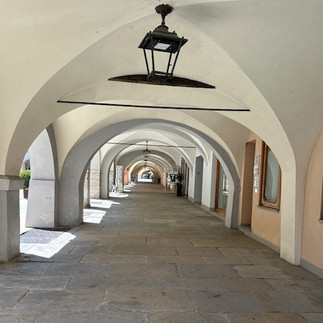







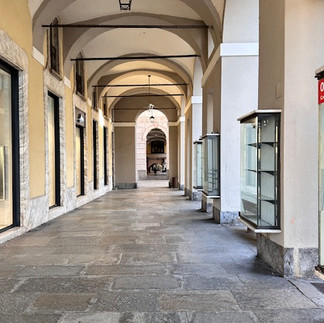

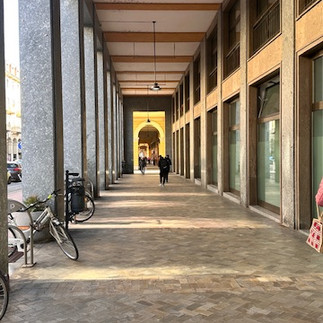


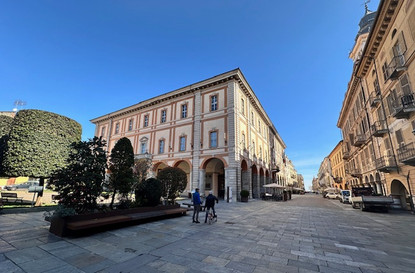





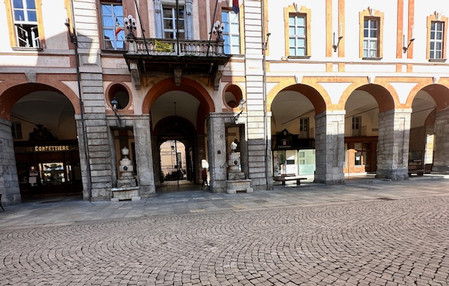





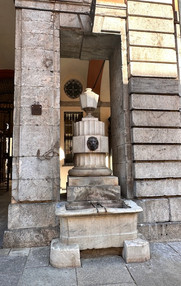

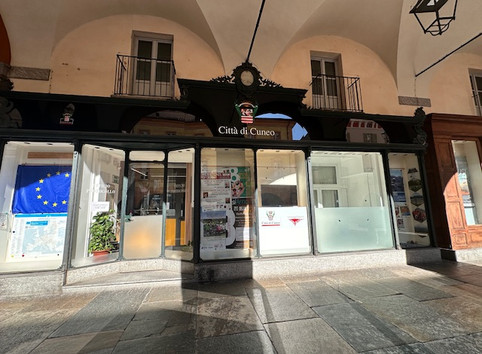















































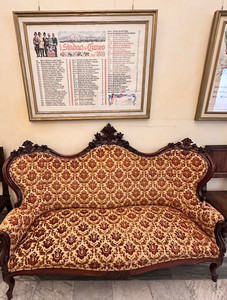

































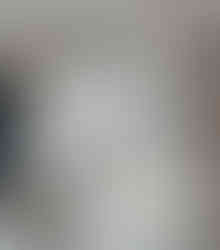




































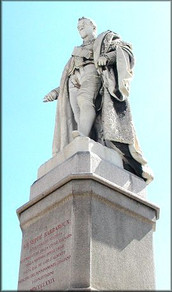


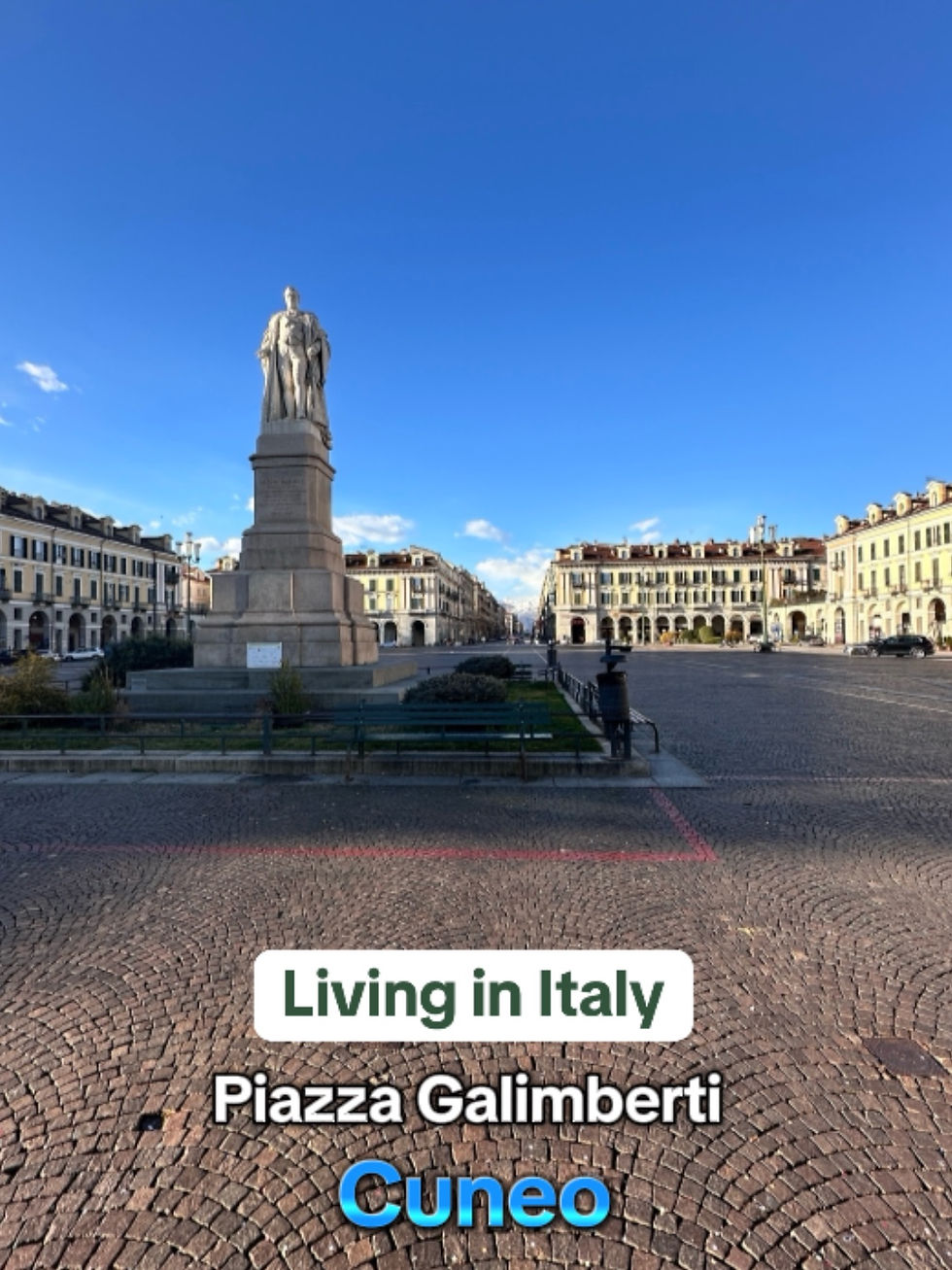



Comments